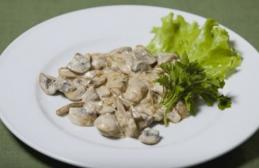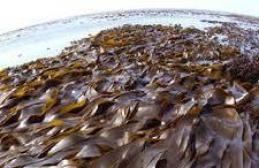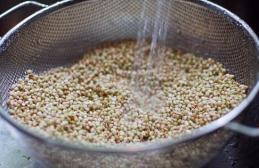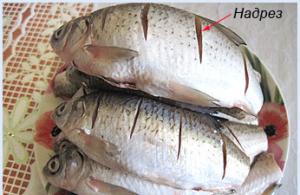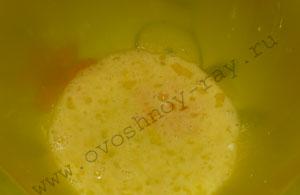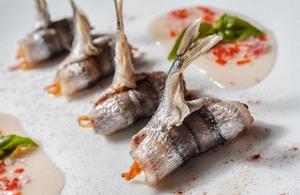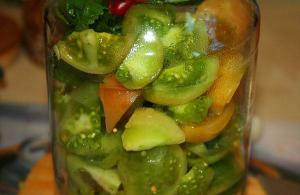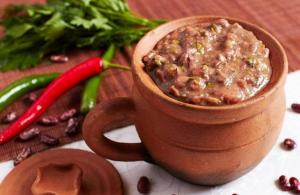Pickling cabbage in 3-liter jars.
RECIPE 1.
QUICK COOKING CABBAGE.
Shred the cabbage into thin strips or cut into pieces. Tight
put in a 3-liter jar. Pour in cold water, dissolving 2 tablespoons of salt in it (1-1.5 liters of water). Leave the jar in a warm place for 2 days. Then
drain a little brine and dissolve half a glass of sugar in it, pour it back into the cabbage, leave for one day, then put it in the refrigerator for storage and consumption. It’s good to sprinkle the cabbage with carrots. grated on a coarse grater.
Line the bottom of the jar with the top cabbage leaves. Finely chop the rest of the cabbage, leaving a few cabbage leaves whole, they will come in handy later. So, grind the shredded cabbage with salt and grated carrots so that it gives juice (this is for soup). If you add salt for an appetizer, add cumin and cranberries. Push tightly into the jar, cover with the remaining cabbage leaves, cover with a clean cloth - and place the weight on top. You can eat it on the second or third day.
RECIPE 2.
FOR ONE 3 LITER JAR
We will need:
1 large head of cabbage
1 medium carrot
1 tbsp. spoon of sugar
salt to taste
Preparing sauerkraut:
Wash cabbage and remove outer leaves. Cut in half and finely chop.
We put it all in an enamel cup or basin - it all depends on the volume of cabbage that you decide to salt for the winter.
Then we knead it with our hands (like dough) so that the cabbage juice is released, and
The cabbage will become translucent. At the same time, you need to salt the cabbage little by little - this will make mashing it easier and faster.
Taste the cabbage all the time, I add salt to taste - in the end it’s cabbage
there should be a few more salts than necessary - the salt will then go away when the cabbage sours.
To start the fermentation process, add sugar, a little about
tablespoon for the whole head of cabbage.
The carrots must be peeled and grated on a coarse grater.
Attention! Put carrots in cabbage only when you are ready to put it in a jar - there is no need to mash carrots together with cabbage - it will be tasteless.
Mix carefully
When all the cabbage is laid, it is necessary to apply pressure.
I use a regular nylon lid as a pressure - it’s quite
enough for this volume.
Press the lid firmly, compacting the cabbage; you will have to do this more than once, because during fermentation gases are formed that tend to lift it to the top. Without pressure, the cabbage will turn out loose and soft, but we want it to be dense and crunchy.
So we finished salting cabbage for the winter, it turned out to be a full 3
liter jar.
But there was a lot of cabbage juice. Do not pour it out under any circumstances!
The labor-intensive process of pickling cabbage for the winter is over, but it's not yet
All!
It will be ready only in three days.
Our further actions are:
Place the jar of salted cabbage in a plate or cup - otherwise all the juice that will rise during fermentation will end up on the table. By the way, we put that small jar of juice side by side on the table (everything will ferment there too).
The cabbage will ferment at room temperature for 3 days.
All this time you will need to free her from the morning and evening.
the resulting gas - hydrogen sulfide - the smell is certainly not pleasant...
but it’s tolerable, the main thing is not to leave it in the cabbage. For this it will be necessary
pierce it to the bottom with a thick knife - you will see how the gas comes out and
you will feel it.
On the first day there will be a little of it, on the second more, and by the evening of the third
During the day, the active fermentation process usually ends, you need to pierce the cabbage 2-3 times a day - the first day, just press the lid and the gas will come out on its own.
When you pierce the cabbage, you need to remove the lid, then put it back
back to the jar, because it will act as oppression.
If there is a lot of juice, pour it into a jar.
By the evening of the third day, sour juice will form in this jar, and it will be somewhat viscous and slimy - don’t be alarmed, this is how it should be.
We pierce the cabbage thoroughly one last time, “squeeze out” all the hydrogen sulfide from it, remove the “oppression”, pour the juice from a half-liter jar, close it with a nylon lid and put it in the refrigerator for storage.
That's all! Now you know how to pickle cabbage in a jar for the winter!
By the way, after a day you will notice that the juice is well absorbed into the cabbage,
so you shouldn’t pour the juice out of the jar if it doesn’t all fit,
just let it sit in the refrigerator next to a 3-liter jar, and after a day or two you will send it there, otherwise the cabbage will not be so juicy and crispy.
RECIPE 3.
SALTY THE CABBAGE IN AN ENAMELED BUCKET.
We take products in the following proportions:
for 10 kg of cabbage:
200 – 250g salt.
If desired, you can add:
500g carrots, grated or cut into narrow strips;
and/or 1 celery root;
or 1 kg whole or chopped apples;
or 100-200g lingonberries;
cumin - to taste.
Chop the cabbage and mix evenly with table salt. For
salt the cabbage evenly, place it in a wider container and
stand for 0.5-1 hour. Next, place the cabbage in a bucket (pan or
cans) tightly sealed to remove air. The surface of the laid and compacted cabbage must be leveled and covered with whole cabbage leaves, which protect it from spoilage. Place a clean piece of white cloth on top, and on top of it a wooden grid (you can use a plate of a suitable diameter) on which to place a weight. You can use a jar of water as oppression. After about a day, the grate (or plate) should be immersed 3-4 cm in the juice released from the cabbage.
When cabbage ferments, gases with an unpleasant odor are released. To remove these gases, you need to pierce the container with cabbage to the bottom with a sharp, smooth stick every 2 days until the release of gases stops.
Cabbage is ready in 15-20 days, depending on
room temperature.
Place the finished cabbage in 3-liter jars and put in the refrigerator.
After removing the cabbage, the surface should be leveled and compacted so that the juice always covers the cabbage, because cabbage left without brine quickly deteriorates and loses some of the vitamin C it contains.
RECIPE 4.
PICKING CABBAGE IN PIECES.
Cooking method:
We cut the cabbage into pieces, put it in jars, and pour each row
carrots, grated on a coarse grater, and chopped garlic. For a 3 liter jar – 1 head of garlic. Don't stuff the cabbage too much!
The brine is prepared like this: for 1 liter of water – 2 tbsp. l. with a top of salt and 150 g
sugar, 100 g 9% vinegar or 1 tbsp. l. essences, 100 g vegetable
oils
RECIPE 5.
CABBAGE MARINATED WITH VINEGAR.
For 5 liters of cold water, take one bottle of vinegar, 2 cups of sugar.
1.5 cups salt, carrots. Cut the cabbage into pieces, you can cut it into 4 parts. Place in a saucepan or barrel. Pour in brine and press.
Place in a room at room temperature for 3-5 days.
Pickled cabbage can be served as appetizers and for meals.
dishes.
Several possible options for mixtures for sauerkraut:
10 kg of cabbage, 25 g of cumin or dill seeds, 200 – 250 g of salt;
10 kg cabbage, 25 g cumin or dill seeds, 100 g dried berries
juniper, 200 - 250 g salt;
10 kg cabbage, 300 – 500 g carrots, 25 g cumin or dill seeds, 200 –
250 g salt;
10 kg cabbage, 400 – 450 g carrots, 350 – 400 g parsnip root,
200-250 g salt;
10 kg cabbage, 200 – 250 g carrots, 150 – 200 g parsley roots,
celery and parsnips, 25 g of caraway seeds or dill, 200 - 250 g of salt;
10 kg cabbage, 300 g carrots, 200 g onions, 25 g dill or caraway seeds,
200 – 250 g salt;
10 kg of cabbage, 500 g of carrots, 100 g of onions, 3 - 4 bay leaves;
10 kg cabbage, 500 g apples, 25 g dill or caraway seeds, 200 - 250 g
salt;
10 kg cabbage, 300 g carrots, 150 g apples, 25 g caraway seeds or dill,
200 – 250 g salt;
10 kg cabbage, 300 – 500 g carrots, 200 g apples, 25 g cumin seeds or
dill, 80 g dried juniper berries;
10 kg cabbage, 200 g cranberries (lingonberries), 100 g carrots, 25 g caraway seeds
or dill, 200 - 250 g salt;
10 kg cabbage, 200 g red rowan berries, 300 – 500 g apples, 25 g seeds
cumin or dill, 200 - 250 g salt;
RECIPE 6.
CABBAGE “GEORGIAN STYLE”.
You will need:
– 1 medium head of fresh white cabbage;
– 1 table beet;
– 1 red hot pepper;
– 4 cloves of garlic;
– 100 g celery greens;
– vinegar to taste;
– 1 tbsp. spoon of salt per 1 liter of water.
Cooking method:
Cut the cabbage into large squares, the beets into thin slices,
Chop celery and pepper.
Place everything in layers, sprinkle with chopped garlic.
Pour a boiling solution of salt, water and vinegar, which should
completely cover the vegetables.
Place in a warm place for 2 days, then in the refrigerator.
Unfortunately, cabbage prepared according to this recipe cannot be
long-term storage.
RECIPE 7.
FEAST CABBAGE.
You will need:
– 4 kg of cabbage;
– 8-12 cloves of garlic;
– 250 – 300 g beets.
For brine per 1 liter of water:
– 2 incomplete tablespoons of salt;
– 2 tbsp. spoons of sugar;
– 8 peppercorns;
– 4 bay leaves;
– ½ tbsp. apple cider vinegar.
Cooking method:
Cut the cabbage into large pieces. Place in an enamel pan, between the pieces of cabbage place raw beets cut into pieces and thinly sliced garlic.
Boil brine from water, salt, sugar, bay leaf and pepper. Remove from heat, add apple cider vinegar. Pour brine over cabbage. Cover the pan with a lid. After 4-5 days, the cabbage is ready.
In winter, you really want to crunch on juicy salted cabbage - it’s delicious and very healthy. But what to do when you live in a city apartment and salting vegetables in a barrel is not an option? An excellent solution is to use glass jars for pickling and replenish the product as you use it.
Classic pickling recipe
There are quite a few recipes telling how to pickle cabbage in jars for the winter. And every housewife can choose the one that suits her and her household best. This method is also good because you can try salting cabbage in different ways throughout the winter. The main thing is not to forget about the rules common to all options for preparing snacks.
Important - Do not pickle frozen cabbage. So, when purchasing, carefully inspect the heads of cabbage. It is better to use later varieties– they have hard leaves that will not turn into jelly during cooking and will crunch appetizingly. It is worth choosing a head of cabbage that is whiter– this is a guarantee of deliciousness and crunchiness.
The so-called classic recipe is very popular among many due to its ease of preparation. Another plus for many is the absence of vinegar when fermentation occurs naturally.
To get this cabbage, you need to prepare:
- three kilograms of chopped cabbage. By the way, today enterprising businessmen often organize the sale of freshly chopped white cabbage and already grated carrots. So if you come across one, a lot of time and effort will be saved;
- grated carrots - depending on your taste;
- water - one liter per jar;
- salt - two tablespoons, but without a “cap” (volume for a liter of water);
- granulated sugar - take two to three tablespoons (also calculated for one liter of water).
Let's start the process.
- If you brought whole cabbage heads from the store, chop them as thinly as possible. This will allow the vegetable not to lose its delicate taste.
- The second step is to grate the carrots from the large mesh side.
- Pour everything into a large saucepan or bowl and mix until you are sure the composition is even.
- In cooled boiled water, dilute sugar and salt until everything is completely dissolved. We will not cook the brine - the cabbage must ferment.
- Pour a liter of brine into a pre-prepared jar (well washed with baking soda, inside and out), then carefully place the cabbage-carrot mixture. We do this until the brine rises almost to the rim.
- Cover with a whole cabbage leaf and place the jar in a cool place.
Salt cabbage without brine
An excellent appetizer - salted cabbage - can also be prepared in a dry way. In this case, you won’t have to fuss with the brine separately, but the result will be excellent.



To pickle cabbage in a jar using the dry method, you will need the following ingredients:
- several cabbage heads weighing five kilos;
- ½ kilogram of carrots;
- ½ cup salt;
- a couple of tablespoons of dill seed.
When everything you need is at hand, you can start pickling.
- First, wash the cabbage and remove any spoiled leaves.
- The next step is to turn the cabbage heads into long straws.
- Now it's the turn of the carrots - grate the peeled root vegetables on the coarse side of the grater.
- Mix vegetable ingredients. Add salt and dill seeds to the cabbage-carrot mixture.
- Mix well and knead the mixture until the vegetables release their juice. No kitchen tools or appliances are needed for this - we use our own clean hands.
- We compact the cabbage tightly into the jars, but so that there is 5-6 centimeters left to the top.
- We place pressure (a glass of water will do) - you need the juice to rise and cover the vegetables.
- The cabbage should ferment for three days, and we will pierce it every day to the very bottom with a stick to release the collecting gas.
- Then you can close the jars with lids and put them away in the cold. In a week, dry-salted cabbage will be ready.
Recipe for sauerkraut with beets - for borscht
Many housewives prefer to ferment cabbage in a jar so that later they can quickly prepare borscht with it - due to the fact that some of the vegetables will already be chopped. To do this, add red beets to the white cabbage. But this method itself is very good as a separate snack or a component for some salad: the cabbage acquires a beautiful color and additional juiciness.

What do you need to collect to make this recipe?
- heads of white cabbage weighing 8 kilograms;
- a couple of medium-sized beet roots;
- garlic - five to six cloves will be enough;
- horseradish root - two or three pieces;
- parsley - take one bunch;
- hot pepper - three pods are enough;
- 200 grams of salt and granulated sugar;
- filtered water - you will need four liters.
Having collected all the necessary components, we proceed according to plan.
- Chop cabbage and beets. We cut the first one into strips with a knife, and pass the second one through a grater. You can also cut the root vegetable into squares if you like larger pieces. This option is not very suitable for use in first courses.
- We also process all other products: finely chop the parsley, put the garlic cloves through a garlic press, and process the horseradish on a fine grater.
- Now you can mix everything and compact it more tightly.
- It's time for the brine. For it, boil water, and then dissolve salt and sugar in it.
- Pour the slightly cooled liquid over the cabbage. In this state, she should spend a couple of days in a warm place.
- Now you can put it in jars and transport it to a cool place - on the balcony or in the pantry. You can try again in a week.
Cabbage prepared in this way can retain its taste and texture for quite a long time. The main thing is to keep it cold.
German-style salted cabbage – with apples and caraway seeds
Some people like it when salted cabbage crunches appetizingly on their teeth, others prefer it to melt in their mouth. For example, this is the option they like in Germany. And the main secret of preparing “melting” cabbage is called a very small, almost thread-like shredder.



What do we need?
- three whiteheads;
- three larger carrots;
- apples – small, but very juicy (take three fruits);
- cumin - three tablespoons will be enough;
- cranberries - two to three tablespoons.
How should we proceed?
- We chop the cabbages very thinly, and equally finely chop the carrots.
- Before using cumin, let’s prepare it: heat a frying pan and fry the cumin for a couple of minutes. Then you need to crush the seasoning in a mortar.
- Core the apples and then cut them into circles.
- We lay out the ingredients in layers: a mixture of vegetables on the bottom, crushed cumin on top, then apples and cranberries. We repeat the sequence until the products run out.
- That’s it, you can cover the composition with oppression and put the container in a warm place for a couple of days.
- When the time has expired, distribute the cabbage into jars and put it in the refrigerator.
Fragrant cabbage with bell pepper and garlic
If you decide not to salt, but to pickle cabbage for the winter, try the recipe that we will tell you about below - using bell pepper and garlic. The vinegar and hot marinade will allow the cabbage to cook much faster than the previously described instructions.
How much you will cook, decide for yourself. The description shows the quantity of products calculated for one kilogram of white cabbage.

So what might you need?
- kilogram of cabbage;
- one not very large bell pepper - preferably red, so that the salad turns out beautiful;
- garlic - five small cloves is enough;
- vinegar - take six percent, ½ cup;
- vegetable oil - 50 grams is enough (if you want additional flavor, you can take “live” sunflower oil);
- granulated sugar and salt - you will need one spoon of each product;
- dried dill and ground black pepper – a pinch is just right;
- water - a liter is enough.
Everything is ready, you can start.
- Cut the cabbage thinner. We also turn the pepper into thin strips with a knife.
- Peel and chop all the garlic. But not into a paste using a garlic press, but cut into thin slices.
- Place all the chopped vegetables in a bowl, season with dill and black pepper. Then we mix everything.
- It's time to start brining. We pour our vinegar and vegetable oil into very hot water, add salt and sugar there and boil it all. Pour the liquid over the vegetable mixture and leave it alone for eight hours. During this time, the cabbage will be well soaked in brine and marinated.

It requires:
- from two to two and a half kilograms of white cabbage;
- three carrots;
- garlic - six cloves is enough;
- water – a liter is enough;
- one hundred grams of granulated sugar and table vinegar;
- a glass of vegetable oil;
- salt - a couple of tablespoons.
You need coarsely ground rock kitchen salt. Iodized is not suitable. And not only for this, but for any recipe (with the exception of cabbage with beets): due to iodine, the salad may lose its whiteness.
- As in all previous options, the vegetables must be chopped. You can immediately put the salad into jars.
- Next, boil water and add bulk ingredients to it. After boiling for a short time, add vinegar to them. Remove the pan from the stove, and only after that pour oil into the liquid and stir.
- Pour the hot marinade over the cabbage-garlic-garlic mixture. When the jars have cooled, the salted cabbage is almost ready to serve. You can transfer the jars to the refrigerator to make it even tastier.
When abundant warm rains irrigate the earth in spring, the home garden thanks you for your efforts with a generous harvest of juicy, vitamin-rich greens. If young cabbage has grown too well and begins to crack due to humidity, pickling or fermenting it for the winter will help preserve the healthy vegetable for a long time. By preparing this valuable gift of the garden for future use, we will significantly replenish the annual reserves of homemade twists, and our gardening exploits will not be in vain.
Our post today may cause surprise, because the question of whether it is possible to ferment early cabbage at home is almost always given a negative answer.
Indeed, pickling early cabbage at home cannot fully replace autumn preparations, but as an additional measure to fill the cellar, this idea is definitely worth taking note of.
Homemade pickling of early cabbage for the winter in layers

Ingredients
- White cabbage— 8 kg + -
- - about 100 g + -
- - 1 large root + -
- — 300 g + -
- - 1 large bunch + -
- - about 8 l + -
- — 400 g + -
- — 400 g + -
Step-by-step pickling of early cabbage: favorite recipe
The beauty of this recipe lies not only in its simplicity and originality. It is equally good for both winter varieties of “capitate” vegetables and for early ones, which are usually not prepared for future use. You need to take tight heads of cabbage with juicy fresh leaves of the same ripening period.
- From washed heads of cabbage we remove the stumps and the top damaged leaves.
- We cut the rest into small slices and put them in a large container (preferably enameled).
- Peel and chop the garlic, peel the beets and grate them on a grater with large holes.
- Wash the parsley and chop it as finely as possible.
- Place cabbage slices in a large enamel container in layers, sprinkling them with beets, parsley and garlic.
- Add salt and sugar to the water, bring it to a boil, stir to completely dissolve the salt and sugar crystals, and turn it off.
- When the filling has cooled to a barely warm state, pour it into a container filled with chopped cabbage.
- In the end, you will need to put something heavy on it and leave it under pressure for a couple of days.
Then all that remains is to spread the finished pickling into clean glass jars, seal with plastic lids and place in a cool place. After 3-5 days you will be able to try home-made fermented crispy cabbage, and leave the rest in the cellar for the time being.
Original homemade spicy pickling of early cabbage
Carrot-cabbage “tandem” is one of the most popular, because these vegetables complement each other perfectly. Spices give them a pleasant piquancy and extend the shelf life of the final product.
Ingredients
- Fresh cabbage heads - 3-4 kg;
- Carrots – 1 large root vegetable;
- Purified water – 2.5 l;
- Dried laurel – 2-3 leaves;
- Carnation – 2-3 inflorescences;
- Pepper – 4-5 peas;
- Dill (seeds) – 1 tbsp;
- Vinegar essence – 2 tbsp;
- Sugar - about a glass;
- Salt - to taste.

Quickly preparing young cabbage at home
- Shred the washed and dried cabbage, add grated carrots, salt, and mix gently.
Attention!
The recipe assumes the use of vinegar essence. It can be replaced with regular 9 percent vinegar (14-16 tablespoons).
The amount of vinegar, salt and sugar varies based on taste preferences.
- To obtain the filling, add spices to the prepared water, add sugar, and boil.
- When the liquid has cooled, you will need to add vinegar essence to it and pour it over the prepared vegetables.
- We knead them slightly, without being too zealous, and leave them like that for 3-5 hours to salt out.
Then all that remains is to thoroughly mix the contents of the pickling container a couple of times, put the pickling into clean jars without sterilizing, close them tightly with plastic lids and store them in a cold place.
The sample can be taken in two days.
Pickled young cabbage: the best recipe with apples
Fruits from your own garden will add a unique aroma to cabbage pickles. We cut them into thin slices, and chop the white vegetable as usual. You can marinate it in slices - it will also turn out delicious.
Ingredients
- Young cabbage - 2-3 medium heads;
- Carrots – 1 pc.;
- Hard apples (medium size) – 2-3 pcs.;
- Water – 1.2 l;
- Salt – 2 tbsp;
- Sugar – 7-8 tbsp;
- Garlic – 2-3 cloves;
- Dill seeds - a pinch;
- Pepper - a few peas;
- Vinegar (9 percent) - about 200 ml.

How delicious and easy it is to pickle early cabbage
We combine shredded cabbage, grated carrots, apples cut into slices (no need to remove the skin from them).
Preparing the marinade:
- put all the spices, including garlic, into the water, add salt, sweeten it, and boil it;
- Next, add vinegar, pour in the vegetables, cover and place a weight on top.
Once the filling has cooled, put the cabbage appetizer into the containers in which we will store it, close it tightly and put it in the refrigerator. Such a treat can be stored for a very long time. But usually its reserves quickly dry up - it turns out very tasty!
If the garden bed is blessed with a bountiful harvest this year, now we will know what to do with it. The answer to the question of whether it is possible to ferment early cabbage is the wonderful recipes offered in today’s selection. They are very simple and universal - they can be used to prepare varieties of white cabbage queen beds of any ripening period.
In a city apartment pickling cabbage in jars for the winter is considered the most acceptable option. The product, as it is eaten, can be prepared again to replenish reserves. Crispy and juicy salted cabbage will come in handy in winter. It is not only very tasty, but also healthy.
Classic recipepickling cabbage for the winter in a jar
There are many different recipes for salting cabbage. From them it is easy to choose the one that your family will like. Or you can experiment during the winter and choose the one that will become your favorite.

There are several rules that should be followed in order for pickling to be successful:
- Cabbage should not be frozen; it should be carefully inspected during purchase;
- Later varieties are better suited for pickling, their leaves are tougher, and they will not become soft like a rag during the cooking process;
- It is better to take white heads of cabbage, their leaves crisp better.
The classic cooking option is simple and therefore very popular. It does not use vinegar; the cabbage is fermented naturally.
Sometimes you can find already chopped cabbage and carrots on sale. Buying such a semi-finished product will help save a lot of time.
So, to prepare juicy cabbage you need:
- 2-3 kg chopped cabbage;
- 1 carrot, grated;
- 1 l - clean water per jar;
- 2 tbsp. l salt without a slide per liter of water;
- 2-3 tbsp. spoons of sugar.
Preparation:
- Chop the cabbage heads as thinly as possible.
- Grate the carrots on a coarse grater.
- Mix vegetables in a large bowl.
- Pour salt and sugar into cold boiled water until completely dissolved. The brine will not boil - this will help the cabbage ferment faster.
- The jar should be prepared in advance, washed with soda on both sides.
- Brine is poured onto the bottom, and a mixture of cabbage and carrots is compacted on top until the liquid rises to the rim.
- Cover with a cabbage leaf and leave in a cool place.
Watch the video! How to deliciously pickle cabbage
Pickling cabbage in pieces
If you don’t want to chop for a long time and don’t have a special vegetable cutter, you can cut the cabbage into pieces.
To prepare you need:
- cabbage 3 kg;
- carrots – 100-200 g;
- head of garlic;
- sugar – 150 g;
- vinegar 9% - 0.5 cups;
- vegetable oil – 100 ml;
- salt – 2 tbsp. l;
- 1 liter of water.
Cooking process:
- Wash the carrots, peel and grate.
- Remove the top leaves from small heads of cabbage and cut into pieces.
- Place a layer of cabbage and a layer of carrots and garlic in jars.
- The brine is prepared as follows: sugar, salt, oil and vinegar are poured into boiling water and dissolved.
- Hot brine is poured into cabbage jars and sealed with a lid.
Important! Do not fill jars to the top. Be sure to leave 7-8 cm to the edge of the neck. Cabbage brine may leak during fermentation.
This version of the workpiece is stored in a cool room. The main secret of success is loose placement of ingredients. If you press the pieces tightly into the jar, they will not be salted. And if you follow the recipe and packing density, the product will turn out healthy and tasty, and it can be stored all winter.
Watch the video! Cabbage, pickled in large pieces
Salted cabbage with beets
This recipe uses white cabbage, which has a relatively neutral flavor. But beets and spices will give it a beautiful appearance and a pleasant aroma.
To prepare you need:
- head of cabbage;
- beets – 2-3 pcs. medium size;
- garlic – 10-12 cloves;
- peppercorns;
- several pieces of bay leaf;
- 2 tbsp. l. salt and sugar;
- apple cider vinegar 0.5 cups;
- water.
The ingredients are indicated for 1 liter of brine.
Preparing pickles:
- Cabbage is cut into pieces; small heads of cabbage can be divided into 4 parts.
- Beets and garlic are peeled and cut into slices.
- Vegetables are laid out in layers in a jar, alternating cabbage and beets with garlic.
- Spices, salt, sugar and vinegar are poured into boiling water.
- Pour the contents of the jar with hot brine, cover with a plastic lid, and leave at room temperature.
This recipe is simple and quick; the cabbage is ready in 4-5 days. It turns out very beautiful and tasty.
Watch the video! Cabbage slices with beets
Spicy Georgian appetizer
Those who love spicy pickles will definitely like this recipe. The appetizer is easy to prepare, but the taste is spicy and interesting.
To prepare you need:
- small heads of cabbage;
- hot pepper;
- beet;
- celery;
- garlic – 4 cloves;
- salt 1 tbsp. l;
- 9% vinegar 2-3 tbsp. l;
- greens 100g.
You can change the amount of spices depending on your own preferences. This quantity is indicated for a 3 liter jar.
Cooking steps:
- The cabbage is cut into cubes; the leaves are not separated.
- Beets and garlic are peeled and cut into thin slices.
- The hot pepper is cleared of seeds and finely chopped.
- Vegetables are placed in a jar in layers, with garlic poured between them.
- The brine is prepared, salt is added to the water and vinegar is poured in.
- Pour hot brine over the pickles in a jar and cover with a lid.
- Cabbage is marinated according to this recipe for 2 days. After which the jar must be placed in a cold place and gradually emptied.
- The finished product will not be stored for long.
Important! You should know that when a vegetable is cut larger, it will retain more vitamins.
In the video you can clearly see how to prepare pickled cabbage in a jar.
Watch the video! Georgian cabbage
Delicious snack can be prepared at home simple and fast.
Original recipe for cabbage with tomatoes
There are many different cabbage preparations in jars, but with tomatoes one of the most interesting ones is obtained.
To prepare you need:
- 5 kg head of cabbage;
- tomatoes 2.5 kg;
- salt – 170-180 g;
- Dill seeds;
- hot pepper pods;
- cherry and currant leaves;
- celery greens.
Salting method:
- Wash the vegetables, chop the tomatoes and shred the cabbage.
- Salt and add spices.
- Vegetables and spices are laid out in layers, a piece of fabric is placed on top and pressed down with a press.
- Cabbage ferments at room temperature for 3-4 days; it must be stirred periodically.
- After this period, the vegetables are placed in jars, sealed with lids and sent to the refrigerator.
This cabbage with tomatoes is tasty and original; it is suitable as an appetizer, a separate dish or for preparing various dishes.
This is the most popular preparation among housewives. There are probably no people who have never tried to pickle cabbage for the winter. Crispy, sour, with various additives, from carrots and apples to various spices. Even honey can be added. Tasty and healthy. A storehouse of vitamins in a jar that will support you all winter. Vitamin C alone is worth it in winter! And you don't need to go to the pharmacy. Mass procurement of this product is just beginning. We won’t stand on the sidelines; we’ll also pickle, ferment, and marinate. To diversify your menu in winter and prepare both the first and second. Or a simple salad with onions and vegetable oil. Persuaded? Shall we cook?
How to pickle cabbage in jars for the winter: a simple recipe
For pickling, take a strong head of cabbage, juicy carrots, salt and water. The cabbage will be salted in salted brine, it is quite easy and not very troublesome. The method is called cold because the brine does not boil. From the simplest and cheapest ingredients you can make a preparation that will turn out not only juicy, but also crispy. It’s convenient to prepare such an appetizer at home, so that at the right moment, when guests arrive unexpectedly, you can treat them to wonderful cabbage!
Ingredients:
- 1 kg. white cabbage;
- 200gr. carrots;
- 150gr. salt;
- 1.5l. water.
How to salt cabbage in jars for the winter so that it is crispy

We leave it in the room to salt for 1-2 days, then close the lids and store it in the refrigerator.


Pickling cabbage in brine for the winter - very tasty recipes

I’ll share a delicious, time-tested recipe for wrapping. Why I love it: for its simplicity and speed of preparation. In just a day you will be able to taste it. Before you even have time to salivate, everything will be ready. And the products are the simplest and most affordable. Exotic is, of course, good, but the soul asks for its own, dear. So, this dish will always be welcome. I am so sure.
What we need:
- 0.5 heads of cabbage;
- 1 carrot;
- 0.5l. water;
- 1 tbsp. salt;
- 0.5 tbsp. Sahara.

How to salt cabbage for the winter

When is it better to salt cabbage for the winter according to the lunar calendar?
Knowledgeable people - astrologers, advise salting only on the waxing moon. 1-3-5 days after the new moon. Then the product is obtained with a pleasant aroma, crispy, white. No mucus or darkening.
You cannot prepare during the full moon or during the waning moon; the result is soft, not tasty, and quickly spoils.
Good days to cook:
- October 2018: 08.10 - 12.10, 18.10 - 22.10, 25.10.
- November 2018: 8.11, 14.11 - 15.11, 17.11 - 20.11, 22.11, 24.11, 25.11.
- December 2018: 12.12, 14.12, 17.12, 19.12, 24.12, 26.12 - 27.12, 29.12.
In ancient times, not only the phases of the moon were noted, but also the day of the week played a significant role in preserving vegetables. They said that if vegetables are feminine, then they should be prepared on the same days - Wednesday, Friday and Saturday. This is probably correct. But already in times closer to us, it was noted that if a man cooks, then his day is Monday or Thursday. And the days set aside for women were Wednesday or Saturday. But the medium was more popular. There was no talk about Friday at all. So everything is relative...
They also navigate by zodiac signs. In what sign does the waxing Moon give the go-ahead for pickling? This is Taurus, Aries, Sagittarius Capricorn. Start chopping. On other days, refrain.
It’s up to you to decide whether or not to follow all the folk signs. In my observation, the variety also plays a big role in proper preparation.
How to properly salt cabbage for the winter
Choose a white cabbage beauty, preferably a late variety. Early or early ripening will not be as particularly crispy. The plug should be elastic, white, without damage, not dry. Color – soft cream. The variety I chose for myself is Geneva, Belarusian is not bad, Slava has also proven itself to be the best. Taste it, there should be no bitterness, the taste is sweet, the sound is crispy. If the head of cabbage is slightly frozen, remove the top leaves and you are ready to use. But if the head is completely frozen, it’s better not to risk it and don’t buy it. Nothing good will come of this.
It is better to take wooden dishes for preparation (barrel, tub), but if this is not possible, use enamel (pan, bucket) or glass (jars). Do not use aluminum or any other - it will oxidize, the vegetable will turn black and taste bitter. I won’t say anything about plastic, you can also add salt in it, but I don’t risk it.
Pickling cabbage in jars for the winter with aspirin
This is a rather controversial recipe. The fact is that acetylsalicylic acid, or aspirin as it is popularly called, is used instead of vinegar. There are enough medications in our lives, skeptics will say and they will be right. Vinegar is a synthetic extract, experts will argue, it is also harmful to the body, one can argue about its safety... And there is nothing to object to. So it's a double-edged sword. But when using aspirin, pickled products are stored for a very long time, almost a year. Moreover, the crunchiness and taste remain unchanged. And here is the recipe itself:
- medium cabbage – 2 pieces;
- carrots – 1-2 pcs;
- sugar – 3 tbsp;
- rock salt – 3 tbsp;
- bay leaf – 2 pcs;
- black peppercorns – 8 pcs;
- acetylsalicylic acid – 2-3 pcs;
- water - for filling.
- Let's prepare the vegetables, peel the cabbage and carrots and wash them under running water.
- We will sterilize the jars.
- We chop the forks into “noodles”, chop the carrots on a grater with large holes. Mix.
- Pour 1/3 tbsp into the bottom of a clean, dry 3 liter jar. sugar, salt, 3 peppercorns, 1 bay leaf. Crush the aspirin tablet into powder. We divide this proportion three times - at the bottom, in the middle and at the end - under the neck of the dish.
- Fill the jars halfway with the vegetable mixture. Then the same proportions of spices, again a vegetable mixture and at the end a spice tablet.
- Boil water, pour the hot liquid into the jar, after 5 minutes add it up to the top, screw on the lid. Leave to cool and then put in a cool place.
Thanks to the small tablet, the cabbage will not ferment, spoil, or become moldy. The color will remain natural, white. It won't affect the taste.
That's the whole recipe. If you liked it and want to cook it, I will be glad that it was not in vain that I shared it.

